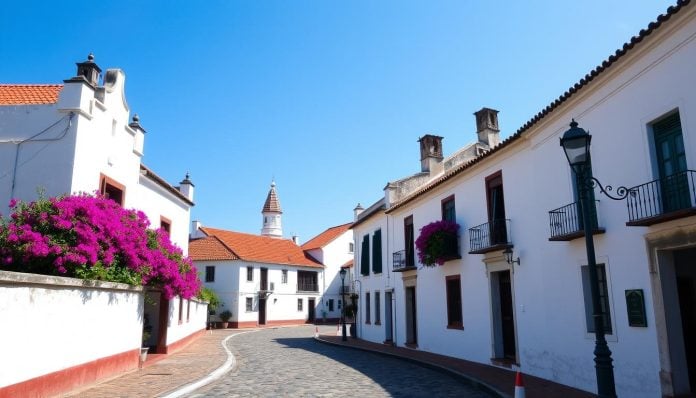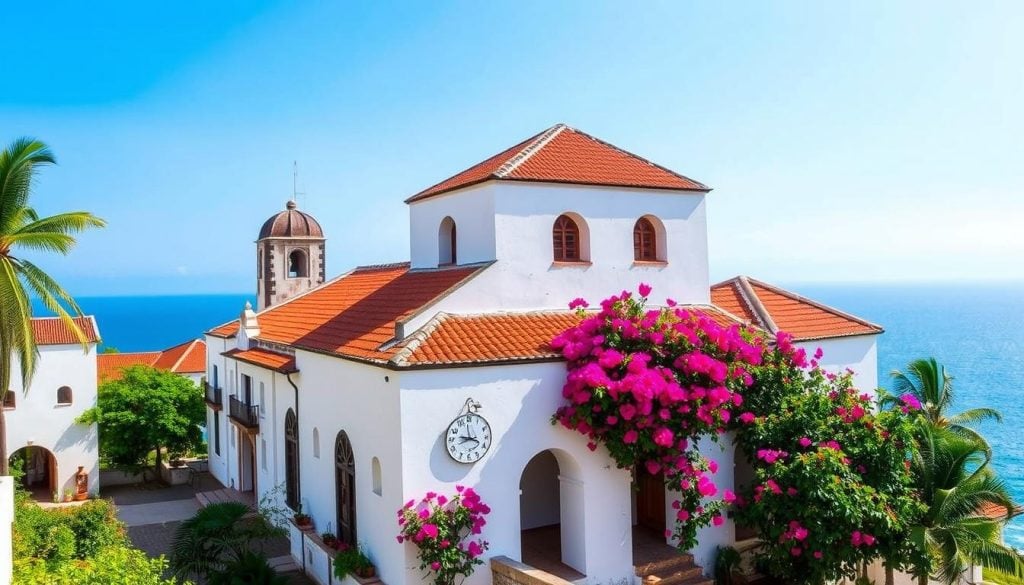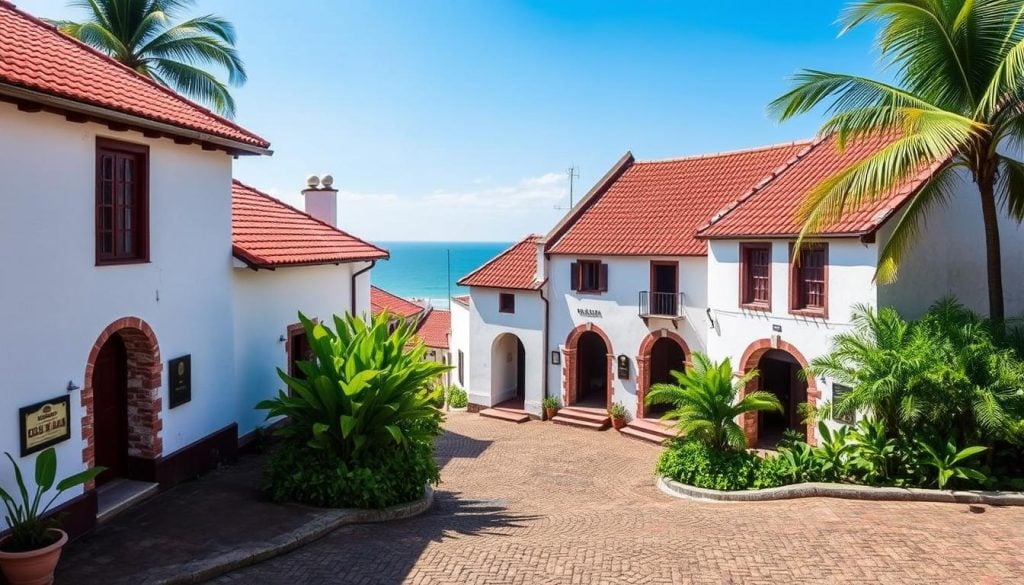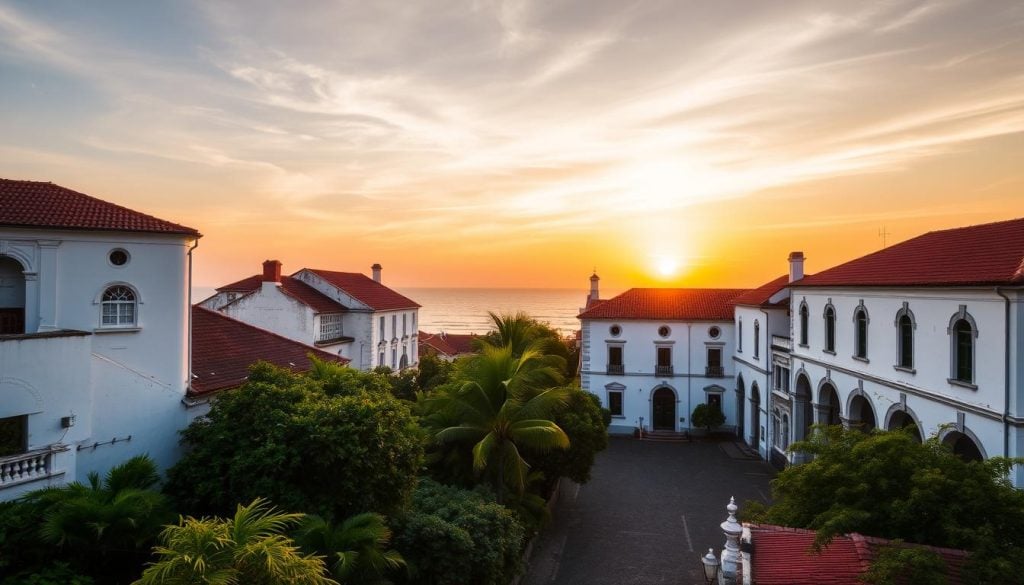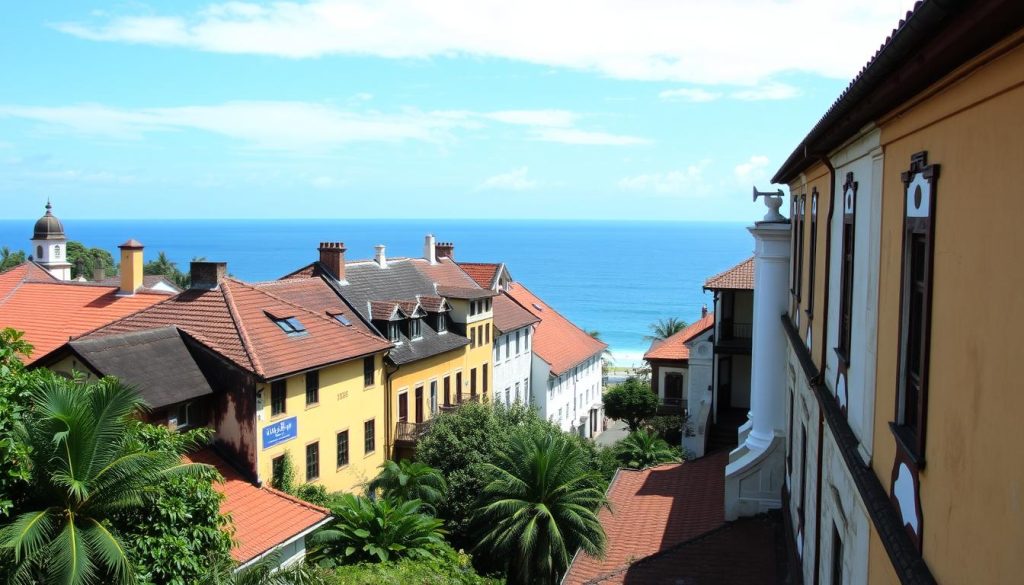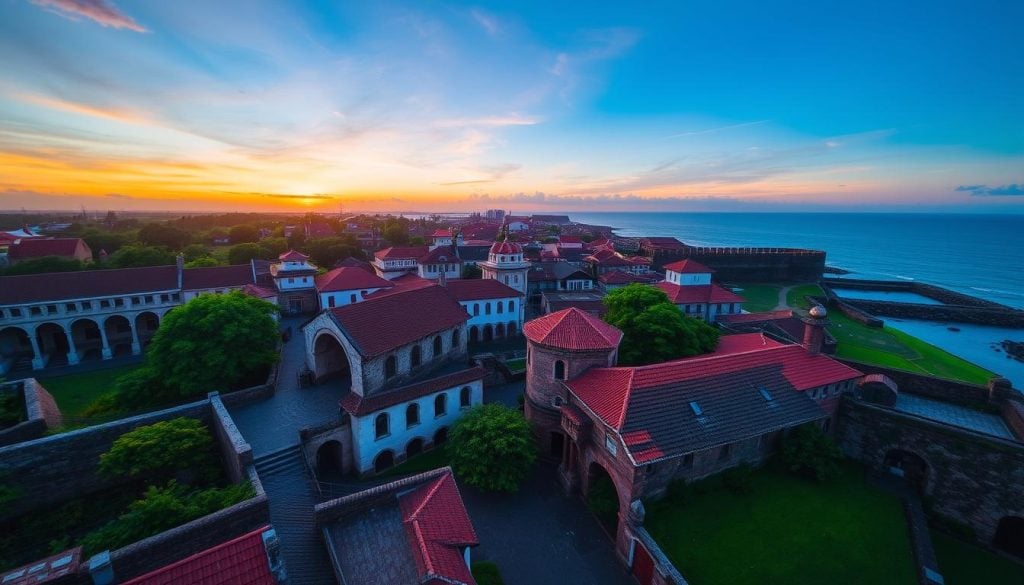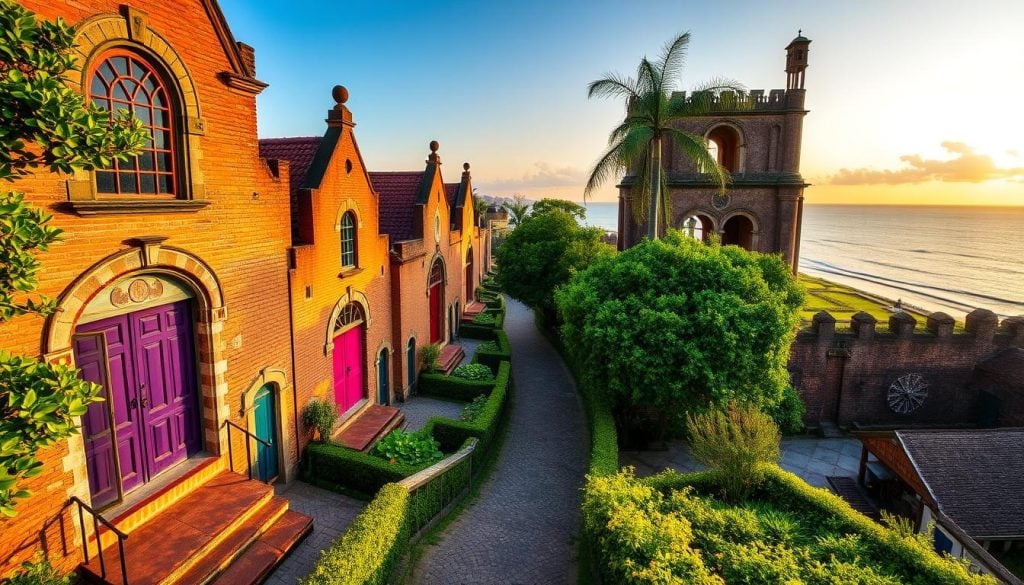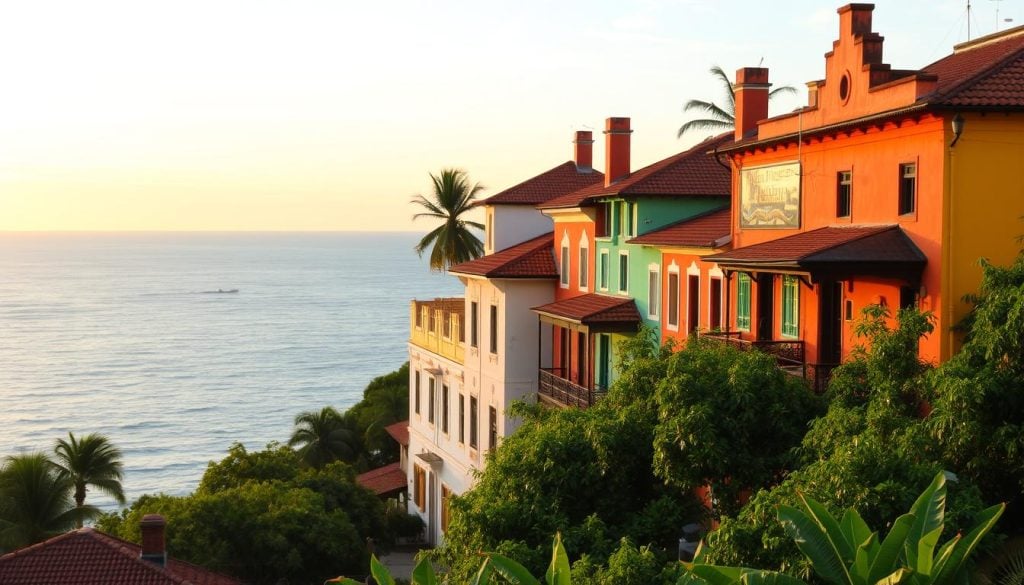Ever wondered how colonial history and local culture blend in one place? Galle Fort, a UNESCO World Heritage Site, is a perfect example. It’s filled with old Dutch buildings that share stories of love, conflict, and cultural mix.
Originally built by the Portuguese in the 16th century, the Dutch took over in the 17th century. They turned it into a key trading port. Now, Galle Fort is a treasure trove of Dutch heritage in Galle. Its architecture and lively vibe make it a top spot for history buffs and culture lovers.
Introduction to Galle Fort’s Dutch Heritage
Galle Fort is a standout example of Dutch heritage in Galle. It beautifully mixes colonial architecture with local culture. Built by the Portuguese and expanded by the Dutch in the 17th century, it shows Galle’s importance as a trading port.
The fort’s buildings give a peek into Dutch architecture in Galle Fort. They create a rich history for visitors to discover.
Walking through the cobblestone streets, you’ll see buildings that still look like they did centuries ago. These preserved structures show how European design fits into a tropical setting. Galle Fort lets you see its architectural journey, showing how old and new coexist.
The fort’s design and buildings tell a story of strength and change. Exploring Dutch heritage in Galle makes your visit more meaningful. It lets you see the beauty and stories in every wall and path.
The Historical Significance of Galle Fort
The Galle Fort history is filled with stories of colonial influence and trade. It’s a key part of Sri Lanka’s heritage. This fortified town was a major hub for traders on the spice routes, making it important for centuries.
Each part of the fort tells tales of strength and change. It shows how the old Dutch buildings are still loved today.
From Portuguese to Dutch to British rule, Galle Fort has seen it all. Its buildings show off detailed designs and a mix of styles from its past. Walking its cobbled streets, you feel the history of these old buildings. They remind us of the fort’s big role in sea trade.
Now, Galle Fort is a UNESCO site, protected for the future. It celebrates a bygone era and draws visitors to explore its history. By visiting, you see the beauty and the deep history that define the area.
What are some old Dutch buildings to see in Galle Fort?
Galle Fort is a UNESCO World Heritage Site with many old Dutch buildings. These structures show the area’s rich colonial history. As you explore, you’ll see landmarks that highlight the era’s architectural beauty. Here are some historical Dutch structures you must see.
Galle Lighthouse – The Iconic Landmark
The Galle Lighthouse was built in 1848 and rebuilt in 1939. It’s a key part of Sri Lanka’s maritime history. Visitors love it for its views of the Indian Ocean and its status as one of the country’s oldest lighthouses.
Galle Fort Clock Tower – A Tribute to Local Heroes
The Galle Fort Clock Tower was built in 1833 to honor Dr. Peter Daniel Anthonisz. It’s a standout example of Dutch architecture, with detailed designs that celebrate local heritage. It’s a must-see for history buffs and tourists.
Groote Kerk – Dutch Reformed Church and Its Unique Architecture
Groote Kerk was constructed in 1640. It’s a gem of Dutch colonial design. Its interiors are well-preserved, featuring floors made from gravestones of Dutch settlers. It’s a moving reminder of the lives of those who lived in Galle.
| Building | Year Established | Significance |
|---|---|---|
| Galle Lighthouse | 1848 (Reconstructed 1939) | One of Sri Lanka’s oldest lighthouses |
| Galle Fort Clock Tower | 1833 | Tribute to Dr. Peter Daniel Anthonisz |
| Groote Kerk | 1640 | Showcases unique Dutch architectural elements |
Dutch Architecture in Galle Fort: A Visual Journey
Exploring Galle Fort’s architecture is like stepping into a story of cultures coming together. Learning about Dutch colonial architecture helps you see Galle’s history in a new light. The mix of local and Dutch styles gives the city its special look.
Characteristics of Dutch Colonial Architecture
Dutch colonial architecture stands out in many ways. It has:
- Gabled roofs: Showing how European styles fit into tropical climates.
- Decorative cornices: Adding beauty to building structures.
- Wide verandas: Offering shade and making outdoor living better in warm places.
These features show the lasting beauty and function of colonial life. Each building tells tales of traders and settlers who lived here.
The Influence of Dutch Design on Galle’s Aesthetic
The Dutch style has deeply influenced Galle’s look and feel. It has shaped public areas and how people interact. The mix of Sri Lankan and Dutch styles offers a unique charm that shows Galle’s spirit.
Exploring Dutch Buildings in Galle Fort
Walking through Galle Fort, you discover the rich history of exploring Dutch buildings in Galle. The mix of old architecture and new touches is seen in the Dutch Hospital. This place has changed a lot over time.
The Dutch Hospital – A Blend of History and Modernity
The Dutch Hospital shows the Dutch Hospital history. It was once a medical center for the Dutch East India Company. Now, it’s a lively spot for shopping and eating. Visitors get to see history come alive while enjoying the views.
Historical Places: The Maritime Museum and Galle National Museum
The Maritime Museum and the Galle National Museum are key Galle heritage sites. The Maritime Museum is in a Portuguese-era building, showing Galle’s role as a seaport. It has maritime artifacts that tell the story of the sea.
The Galle National Museum, founded in 1656, shows Sri Lanka’s cultural growth. It has colonial relics and artworks. Both museums help you understand Galle Fort’s history.
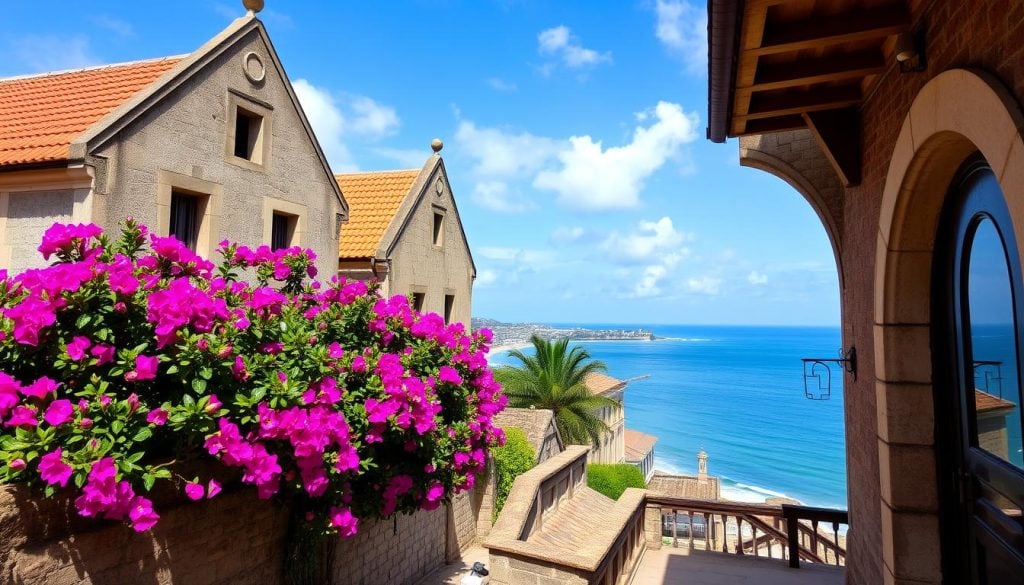
Top Dutch Heritage Sites in Galle Fort
Exploring the top Dutch heritage sites in Galle lets you dive into the area’s rich history and architecture. Two sites stand out for their unique roles in Galle Fort’s history.
Zwart Bastion – The Oldest Bastion
Zwart Bastion is the oldest bastion in Galle Fort. It shows the Dutch’s engineering prowess during their colonial rule. The bastion’s history is fascinating, revealing how it helped protect the coastal settlement.
Its strong design and high views offer a glimpse into the past. They also show the defensive strategies against invaders.
Flag Rock – A Symbol of Strategic Defense
Flag Rock is a key historical site, once home to cannons that guarded Galle Fort’s south. Now, it’s famous for its breathtaking sunsets. It’s a place where history meets today’s beauty.
Its views and calm atmosphere make it perfect for reflecting on the past and present.
Old Dutch Landmarks in Galle Fort to Discover
Galle Fort is filled with cultural landmarks that tell a story of history and architecture. The Meeran Mosque and Sudharmalaya Temple are key sites. They show the area’s rich cultural heritage and history.
Meeran Mosque – A Cultural Blend
The Meeran Mosque’s history is a mix of architectural styles. It combines Islamic, Baroque, and British Victorian designs. This shows how different cultures influenced Galle Fort.
Its stunning façade and detailed designs make it a must-see. Visitors can learn about the history and religious practices here.
Sudharmalaya Temple – A Testament to Religious Diversity
The Sudharmalaya Temple is important for its cultural significance. It was built on a former Roman Catholic Church site. This temple shows how different faiths live together in Galle Fort.
The temple’s bright colors and detailed carvings highlight its role in the area’s history. It celebrates the diversity of religions in the region.
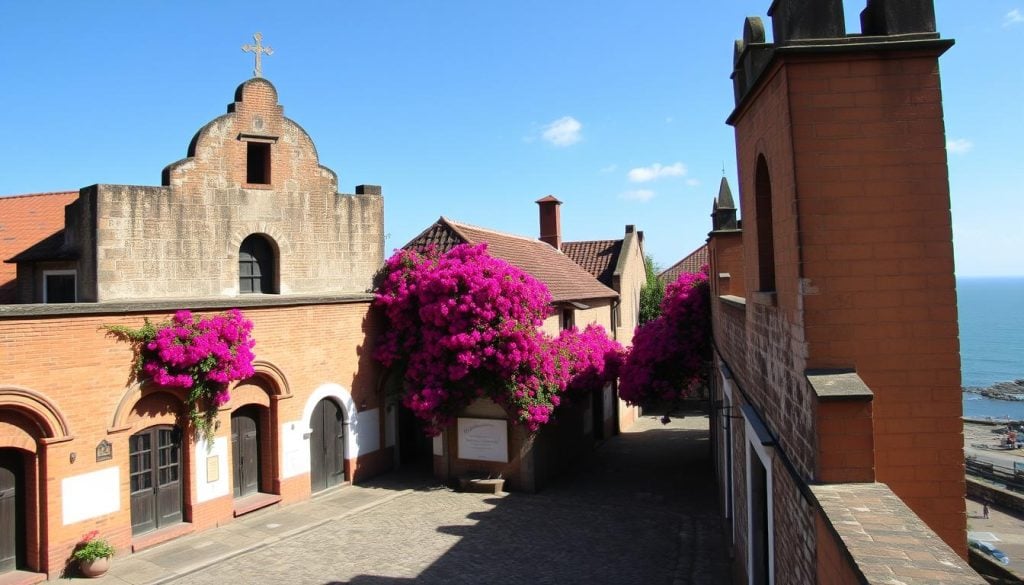
Galle Fort Dutch Architecture Tour Recommendations
Exploring Galle Fort’s architectural wonders is a must-do. You can pick from guided walking tours that dive deep into history or self-guided tours for a personal touch. Each choice fits your exploration style.
Guided Walking Tours Within the Fort
Guided walking tours offer a rich look at Galle Fort’s architecture. Guides share stories of the buildings, like the Galle Lighthouse and Groote Kerk. They also talk about the fort’s Dutch colonial past. These tours help you see the beauty in Galle Fort’s details.
Self-Guided Exploration Tips
Self-guided tours in Galle offer freedom. Here are tips to enhance your experience:
- Start at the Galle Fort entrance and get a map of key sites.
- Wear comfy shoes for the cobbled streets.
- Stop at local cafés and shops in old buildings.
- Have your camera ready for the architecture and street life.
| Tour Type | Description | Pros | Cons |
|---|---|---|---|
| Guided Walking Tours | Led by knowledgeable guides highlighting history and architecture. | In-depth knowledge, engaging anecdotes. | Fixed schedule, less freedom to explore. |
| Self-Guided Tours | Explore at your own pace, following a personalized route. | Flexibility, discover hidden gems. | Requires more planning, less historical context. |
Must-See Dutch Buildings in Galle Fort
To truly experience the charm of Galle Fort, you must explore its historical streets. Each corner reveals a story and invites you to appreciate the must-see Dutch buildings. These buildings stand as testaments to the area’s rich heritage. As you walk, the atmosphere is filled with the sounds and sights of a vibrant community.
Historical Walks Through the Fort’s Charming Streets
Engaging in a walking tour through Galle Fort’s captivating streets allows you to immerse yourself in its historical ambiance. The cobblestones beneath your feet and the colonial architecture surrounding you enhance the sense that you have stepped back in time. Key routes to consider include the streets leading to the Galle Lighthouse, where quaint homes and bustling shops reveal the local culture.
Local Cafés and Boutiques in Restored Colonial Buildings
While discovering these historic streets, you will encounter delightful spots for local dining in Galle Fort. Many cafes nestled in restored colonial buildings serve delicious meals with a local twist. These establishments not only provide a taste of Galle’s culinary scene but also offer a glimpse into the town’s architectural beauty. Boutiques nearby feature a range of artisanal goods, making it easy to take home a piece of the area’s history.
Experiencing the Charm of Galle Fort
To truly appreciate Galle’s charm, you must dive into its vibrant culture and history. Walking through the fort’s ancient streets, you’ll see a mix of old buildings and greenery. The cobblestone paths take you to quaint boutiques and artisan shops, showing off local skills.
Exploring Galle Fort means visiting lively markets and enjoying street shows. These shows highlight the area’s rich heritage. Also, try the traditional Sri Lankan food at local restaurants. Each dish tells a story of the fort’s cultural mix.
Watching the sunset at Flag Rock is a must. The view is stunning, making you feel like you’re in a historical wonderland. Every moment in Galle Fort is a mix of history, culture, and beauty.
Conclusion
Exploring Galle Fort is like stepping into a world of history and culture. The Dutch buildings show the island’s rich past. They mix European styles with local traditions beautifully.
Walking the streets, you’ll see amazing sights like the Galle Lighthouse and Groote Kerk. These places tell stories of trade and defense. It’s a journey that fascinates everyone.
Visiting Galle Fort is an experience you won’t forget. It’s a mix of old history and new vibes. Your visit will be both meaningful and unforgettable.

































